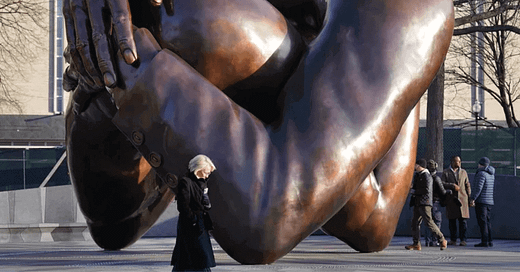MLK Boston Statue is a Good Example of Bad Modern Art
Modernism in architecture, according to Justin Shubow, the author of CSS’s curricular resource The Architecture of Democracy, follows “the spirit of the times.” Modernists themselves make that grand claim. But in its disdain for past artistic tradition and for realistic depiction of what we see around us, Modernism has infected not just architecture, but many other forms of art.
So much of modern art is an eyesore precisely because of this break with the past and with realistic depiction of its subjects (victims?), and the new Martin Luther King, Jr. sculpture in the Boston Common—titled The Embrace—is a case in point. If you haven’t seen the sculpture, take a look. The work, which consists of two pairs of disembodied bronze arms grasping each other, is supposed to reflect a photo of MLK and Coretta Scott King hugging after the legendary civil rights leader was awarded the Nobel Peace Prize. Instead of evoking the moment’s triumph, The Embrace looks like an eldritch horror summoned up from some Lovecraftian nightmare.
But this work of anti-art serves a good purpose: it is so over the top that the public isn’t afraid to notice. NPR called the public reaction to the sculpture “decidedly mixed,” but it’s really been decidedly bad. NPR could only cite Boston’s mayor as the single person who appreciates the statue–everyone else seems to recognize it for the monstrosity it is.
The Embrace shows that rejecting centuries of artistic tradition is hubris. Artists’ works can benefit enormously by building on the genius of previous masters like Michelangelo, Leonardo da Vinci, and Rembrandt, who themselves found inspiration in past artists without copying them stroke for stroke. By separating themselves from the past, today’s Modernist painters, sculptors, and architects are dismissing centuries of accumulated experience.
The bronze abomination in the Boston Common also showcases modern art’s disdain for beauty and realistic depictions. Much of today’s “art” is, in the words of the British philosopher Sir Roger Scruton, dominated by a “cult of ugliness.” You don’t have to look far to see his point: besides The Embrace, other notable works of modern art include a dead shark in formaldehyde, an unmade bed surrounded by alcohol, paint splotches, or a light going on and off. Compare any of these works with the beautiful solemnity of Rembrandt’s The Three Crosses or the easy-going joyfulness of Renoir’s Luncheon of the Boating Party.
Scruton said that “the beautiful work of art brings consolation in sorrow and affirmation in joy,” and art historian Dianne Durante says that good art can be not just “a source of contemplation and joy,” but also of “inspiration and spiritual fuel.” You should walk away from a good work of art feeling energized, encouraged, and hopeful—not scratching your head in confusion.
Modernism rejects art as a vehicle of transcendent beauty and purpose and leaves us with paperweights that look as pleasant as a mousse made from pencil shavings. You don’t need a Ph.D. in art history to recognize the difference between the beautiful and the ugly. The fact that The Embrace has provoked widespread mockery and indignation from multiple sources, including social media, the Washington Post, and MLK’s niece Alveda King shows us that many people can tell instinctively when a work of art is good. Show any person on the street side-by-side pictures of Raphael’s School of Athens and the aforementioned dead shark and ask them which one is more beautiful: my money is on most of them voting for Raphael. Beauty speaks for itself.




